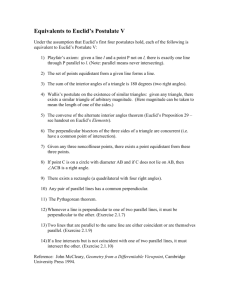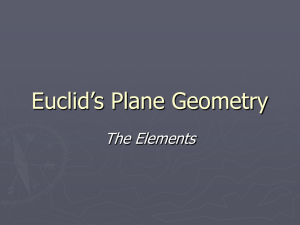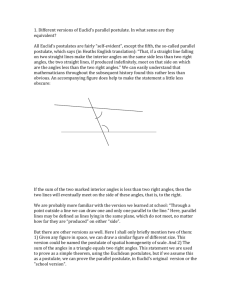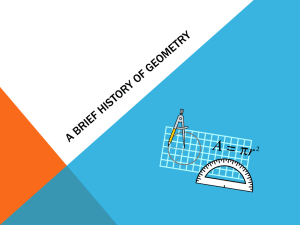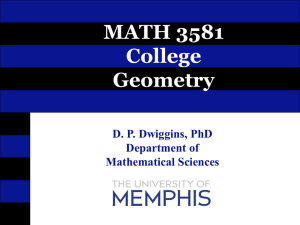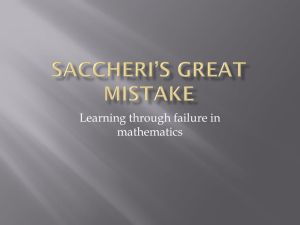Euclid`s Geometry
advertisement
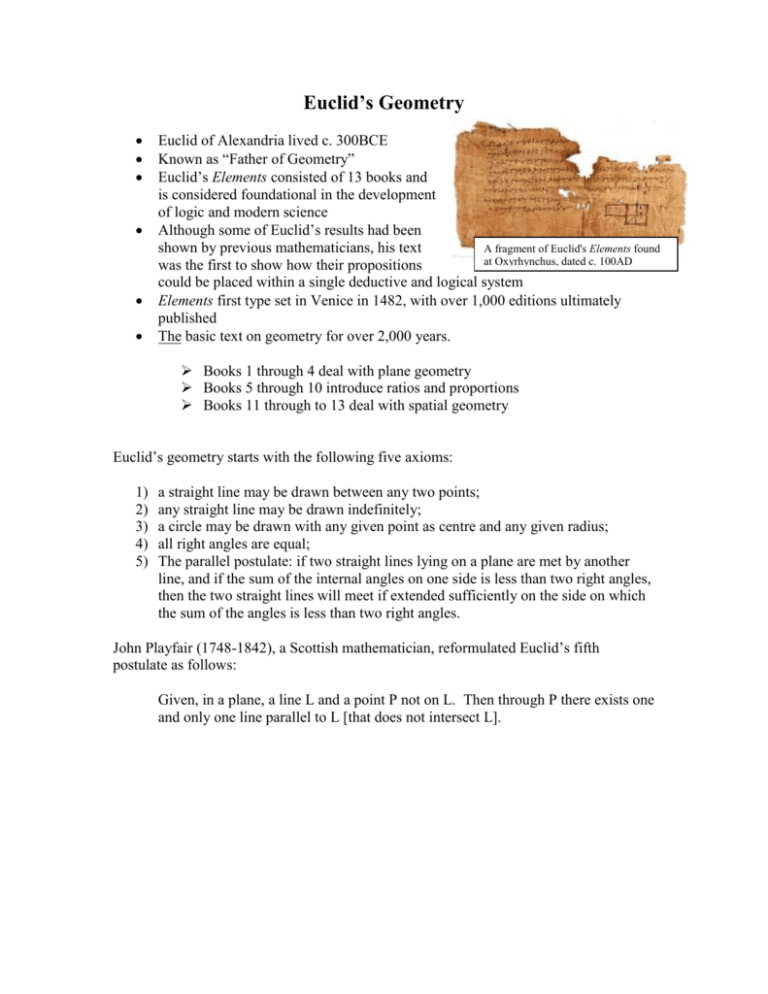
Euclid’s Geometry Euclid of Alexandria lived c. 300BCE Known as “Father of Geometry” Euclid’s Elements consisted of 13 books and is considered foundational in the development of logic and modern science Although some of Euclid’s results had been A fragment of Euclid's Elements found shown by previous mathematicians, his text at Oxyrhynchus, dated c. 100AD was the first to show how their propositions could be placed within a single deductive and logical system Elements first type set in Venice in 1482, with over 1,000 editions ultimately published The basic text on geometry for over 2,000 years. Books 1 through 4 deal with plane geometry Books 5 through 10 introduce ratios and proportions Books 11 through to 13 deal with spatial geometry Euclid’s geometry starts with the following five axioms: 1) 2) 3) 4) 5) a straight line may be drawn between any two points; any straight line may be drawn indefinitely; a circle may be drawn with any given point as centre and any given radius; all right angles are equal; The parallel postulate: if two straight lines lying on a plane are met by another line, and if the sum of the internal angles on one side is less than two right angles, then the two straight lines will meet if extended sufficiently on the side on which the sum of the angles is less than two right angles. John Playfair (1748-1842), a Scottish mathematician, reformulated Euclid’s fifth postulate as follows: Given, in a plane, a line L and a point P not on L. Then through P there exists one and only one line parallel to L [that does not intersect L]. Non-Euclidian Geometry In the 19th C different people discovered – quite independently – that Euclid’s fifth postulate (and Playfair’s reformulation) didn’t quite hold up. They proposed that if not on a flat plane, but a curved one, that the Euclidian axioms wouldn’t apply, particularly the 5th. Picture curved surfaces like the outside of a sphere or the inside of a bowl. Bernhard Riemann (1826 – 1866) A German mathematician credited with discovering, in 1854, Riemannian Geometry that includes (but is not limited to) elliptic geometry. Reimann substituted for Euclid’s Fifth the following: Given a line L and a point P not on L there is no line in the plane of P and L that passes through P and does not meet L (i.e. parallel lines do not exist). Elliptic geometry The simplest model for elliptic geometry is a sphere, where lines are "great circles" (such as the equator or the meridians on a globe), and points opposite each other are identified (considered to be the same). In the elliptic model, for any given line ℓ and a point A, which is not on ℓ, all lines through A will intersect ℓ. It should be noted that elliptic geometry is not simply a coordinate system whereby Euclidean 3-dimensional space is measured. Rather, elliptic geometry posits that our Euclidean "flat" planes simply do not exist what we perceive to be flat planes are themselves spheres. Note that in the elliptic model the sum of the angles of a triangle is greater than 180°. source: http://en.wikipedia.org/wiki/Non-Euclidean_geometry Nikolai Ivanovich Lobachevsky (1792 – 1856) A Russian mathematician sometimes credited as the “Copernicus of Geometry” for his revolutionary re-thinking of the existing Euclidian paradigm. In his Hyperbolic Geometry Euclid’s 5th Postulate is replaced, as it is proven false (in a saddle-shaped surface there can be more than one line parallel to L that that crosses the point P that is not on L). There is also the possibility of an infinite number of ultra-parallel lines. Note, as per the diagram, that a triangle is possible with the sum of its angles being less than 180°. Source: http://en.wikipedia.org/wiki/Hyperbolic_geometry Take home point: Euclid’s postulates are as correct now as they were nearly 2000 years ago and this might make Mathematics a unique field of human endeavor. His postulates continue to apply to flat planes. But what if there is no such thing as a flat plane? What are the implications of this for Mathematics as a knowledge system?
